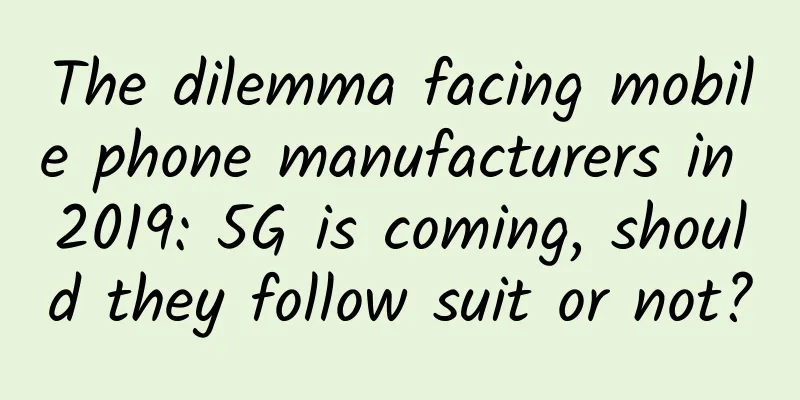The dilemma facing mobile phone manufacturers in 2019: 5G is coming, should they follow suit or not?

|
In the mobile phone industry, the battle for 5G is already underway. In addition to Apple, mobile phone manufacturers from Xiaomi, OPPO, Vivo to Lenovo, ZTE and HTC have all unveiled their 5G strategies and brands. OPPO and vivo both plan to launch 5G mobile phones in 2020. According to the earlier statement of Huawei's rotating chairman Xu Zhijun, Huawei expects to release 5G mobile phones in the second half of 2019. HTC has also made a bold statement to launch 5G mobile phones in 2019. The 5G network will be built in 2019 and put into trial commercial use in June 2019. Relatively speaking, Huawei is an early entrant, of course, this is not without reason, because the concept of 5G is almost tied to the Huawei brand. Huawei has launched a full set of 5G commercial network solutions based on non-standalone networking (NSA), and will launch a 5G commercial system based on standalone networking (SA) in March next year. It has currently obtained 25 5G commercial contracts. Among domestic mobile phone manufacturers, only ZTE and Huawei can penetrate into standard setting and network construction solutions.
5G is the future, but it cannot replace 4G for the time being 5G is the future, there is no doubt about that, but this future is not that close yet. It is said that the 5G infrastructure in most markets in the United States is not ready in 2019. In China, the three major operators have obtained nationwide 5G low- and medium-band experimental frequency use licenses. The current standards for some frequency bands of 5gR15 have been postponed, and the 5G frequency band will be far more than 4G. The spectrum is the basic resource for the development of 5G, but the spectrum resources are very tight. According to the forecast of the International Telecommunication Union, by 2020, the international mobile communication frequency demand will reach 1340MHz-1960MHz, and the Chinese mobile communication frequency demand will be 1490MHz-1810MHz, and the spectrum gap will reach 1000MHz. In addition, the number of 5G base stations may also increase several times. "In the 2G era, the coverage radius of a base station was two kilometers; in the 5G era, with different frequencies used, the coverage radius of a base station may be only 500 meters, which requires more investment and more base stations." Jin Haitao, chairman of Qianhai Ark Asset Management Co., Ltd. and chief executive partner of Qianhai Fund of Funds, pointed out that the number of 5G base stations will be twice that of 4G base stations in the future, and the investment requirements for operators in 5G network construction will be at least 1.5 times that of 4G. Although the three major operators are actively deploying 5G network construction, completing the networking is a huge systematic project. Secondly, on the technical level, the technologies involved in the 5G era, such as millimeter wave, small base stations, Massive MIMO, full-duplex and beamforming, are not yet mature. On the other hand, 5G requires 5G chips, but no manufacturer has released 5G chips yet. The construction of 5G network cannot be achieved overnight. 3G mobile phones entered the market in 2008 and 4G mobile phones entered the market in 2014. It took China 6 years to transition from the 3G to the 4G era. 5G networks also require licenses, but domestic licenses have not yet been issued. In the commercial stage, 5G will only cover a few hot spots in large cities. It will take a long time for 5G to replace 4G and reach the stage of technological maturity and seamless coverage of 5G networks. Deloitte predicts that about 25 operators around the world will launch 5G networks in 2019, and 26 operators will launch 5G networks in 2020. In addition, in the initial stage, due to the high price of 5G mobile phones, it is more of a packaging concept. There are enough areas that need to be optimized in the experience of 5G mobile phones. The market will also face a series of problems such as the additional power consumption caused by the performance improvement of terminals supporting 5G and how to achieve multi-antenna design in a limited space. At the operator level, there are many factors such as base stations, signals, operations, and prices. It will take some time to fully mature and achieve signal strength and range comparable to 4G and to achieve a reasonable level of cost and price. In addition, from the perspective of the current 4G mobile phone market, the Internet experience provided to people is already very sufficient. At present, there are no obvious shortcomings in terms of transmission speed or functional experience. That is to say, although 5G can be faster, its peak theoretical transmission speed can reach tens of Gb per second. Due to the huge throughput, low latency and other improvements of 5G, its commercial value in industrial Internet such as the Internet of Things may be even greater. But for mobile phone users, transmission speeds of tens of Gb per second, real-time transmission of 8K resolution 3D videos, or downloading a 3D movie within 6 seconds seem to have nothing to do with the current core experience pain points. After all, downloading large-capacity data, movies and other files is an occasional demand and has nothing to do with the core demand of rigidity. In the consumer Internet market facing 5G mobile phones, faster transmission speeds certainly provide a better experience, but high prices may be an obstacle. After all, according to the 2017 resident income data released by the National Bureau of Statistics, the per capita disposable income of residents in China was 25,974 yuan in 2017, so it is not realistic for everyone to spend 8,000 yuan to buy a 5G mobile phone. Therefore, 5G is the future, but it cannot replace 4G for the time being. On the other hand, 4G phones and 5G phones should have 90% similarity, including hardware modules (touch screen interaction, camera audio, etc.), and the use of operating systems and application software will be exactly the same. Therefore, the hardware and appearance of the first batch of 5G mobile phones on the market will not be much different from 4G. The biggest difference lies in the communication module, that is, the 5G baseband chip, which is responsible for receiving and sending data. The performance of the baseband chip basically determines the performance of the main processor chip of the mobile phone. In other words, the 5G chip can enable the mobile phone to achieve a theoretical data download speed of up to 10Gbps. Therefore, except for Huawei, in the 5G era, manufacturers basically find it difficult to get rid of their heavy dependence on Qualcomm. Mobile phone manufacturers and operators need 5G more than users In every technological revolution in the mobile phone industry, there has been a group of manufacturers chasing the trend, but it should be noted that the components and antenna area of 5G mobile phones will increase, posing a huge challenge to the industrial design and product innovation of mobile phones. When the new 5G technology starts, the immaturity of product innovation, power consumption and other aspects will affect user experience and reputation. In fact, users still lack clear demand for 5G. The upgrade from 4G to 5G is a leap from 80 points or even 85 points to 100 points, but 80 points can already meet the needs of the vast majority of users. Today, users do not seem to have too strong demands for the pain point of mobile phone transmission speed. In the short term, due to the higher prices and service package fees of 5G, there will be many areas in the product experience in the early promotion stage that need to be continuously polished and optimized, and it is not realistic to popularize it in a short period of time. But in today's smartphone market, the overall environment is going down. According to an IDC report, in the third quarter of 2018, global smartphone vendors shipped 355.2 million smartphones in this quarter, a year-on-year decrease of 6%. The current wave of replacement has passed, and 2019 may be a difficult year, with the overall trend still downward. In the final analysis, in the current environment, mobile phone manufacturers and operators need 5G more than users. In the book "Brand Relevance" by brand management scholar David Aaker, there is such a view: innovation often develops from incremental innovation to substantial innovation. When innovation is substantial innovation, significant product improvements will make other brands lose their competitiveness in consumer choices. Compared with 4G, the innovative experience brought by 5G can be regarded as substantial innovation, which is an opportunity for domestic mobile phones to surpass. From the perspective of mobile phone manufacturers, as the replacement cycle continues to lengthen, the factors that tempt users to change their phones are becoming more and more elusive. 5G is a very tempting factor for users to change their phones. The 5G high-speed network era is an important time point for operators to increase traffic charges in order to improve performance, because the re-setting of traffic package charges for 5G users and the performance and revenue growth brought about by the large-bandwidth traffic consumption in the industrial Internet field are very considerable. Therefore, 5G involves the possibility of mobile phone manufacturers and operators breaking the current profit structure and reshaping the cake. So, although users are not in a hurry to use 5G, because the current 4G experience is relatively perfect, mobile phone manufacturers and operators may not be able to wait. In this situation, manufacturers are more eager than users to use the concept of 5G to drive the demand for replacement, and they are also eager to leave consumers with a brand impression of being a 5G pioneer. However, from this anxious mentality, we can know that manufacturers are passively following the 5G trend. Launch new phones first or lay low for future plans? There is a saying that goes, don't take on a job if you don't have the skills. Taking the lead may not necessarily help you gain a firm foothold, and you are more likely to become cannon fodder in the early stages. Judging from the timetable, 5G mobile phones were in the trial stage in 2019. The reason for their high prices is that the hardware costs of mobile phones are increasing, and the costs of connecting related core components, debugging, and research and development are very high. The cost investment in 5G research and development and network construction needs to be spread over the price of mobile phones to recover profits and funds. Looking at the development experience of 3G and 4G networks, when network construction produces scale effects, low- and medium-priced terminals will become mainstream. Moreover, the 5G industry chain involves telecom operators, equipment manufacturers, chip companies, and terminal companies. The entire industry chain needs to cooperate to promote the maturity of the entire 5G network. The popularization of 5G is limited by the layout and promotion speed of all parties. For domestic mobile phones, it is very important to keep up with the deployment rhythm of operators for 5G. Judging from the mainstream price range of mobile phone terminals in the future, only when 5G mobile phones enter the 3,000-4,000 range will the market enter a stage of vigorous explosion. Therefore, for mobile phone manufacturers, the early layout should not just be a rush to release the first 5G mobile phone, but should focus on the trends in the next 3 to 5 years. An obvious trend is that 5G will support the development of industrial Internet and usher in the era of the Internet of Things. When all products can be connected by 5G, mobile phone operating systems will need to be upgraded and transformed. What mobile phone manufacturers need to think about is, while operators are pushing for the maturity of technology and the industrial chain, what revolutionary changes 5G will bring to smartphones, whether the application innovation experience it brings will be combined with AR and VR, and what new functions and application innovation demands consumers will have under the 5G network. Focusing on these trends, deploying new businesses such as the Internet of Things, cloud, and big data, and making a more complete software and hardware ecosystem layout is a good strategy. There is no doubt that 5G is another new wave of dividends for Huawei and ZTE. At present, Huawei has become the world's largest telecommunications equipment supplier and has cooperated with 42 operators around the world to launch multiple 5G pre-commercial networks; ZTE has currently applied for more than 1,500 patents, and its pioneering Pre5G products have been deployed in more than 60 networks in more than 40 countries, which also indirectly brings new development dividends to the mobile phone business of these two major manufacturers. In 2019, 5G will be officially built. According to the law, the existing 4G LTE will continue to evolve and become an important part of the 5G platform. Moreover, 4G, 3G, and 2G networks will continue to work after 5G is commercialized. 5G will really arrive after 2021. By then, the infrastructure and software and hardware equipment of the 5G network may be almost ready. However, at present, the profits and sales of many mobile phone manufacturers are continuing to decline, and new concepts are needed to enter the market, especially those manufacturers who lack core technologies. According to Qualcomm's earlier announced 5G patent licensing rates: single-mode 5G mobile phones are charged 2.275%, and multi-mode 5G mobile phones are charged 3.25%. This does not include the patent fees already paid to them. Therefore, mobile phone manufacturers who use Qualcomm's 5G chips to display the signs of 5G mobile phones will have to pay more Qualcomm taxes. But what you need to know is that Qualcomm is only a chip manufacturer, not a communication network equipment manufacturer. It cannot dominate the core of the communication network. The core is in the communication network equipment. Due to competition from Huawei, Samsung and other manufacturers, Apple stopped using Qualcomm and helped Intel to take the lead. HiSilicon, Sequans and other manufacturers have steadily planned for growth. Qualcomm's bargaining power and monopoly position in 5G patents are no longer as stable and strong as before 4G. Clinging to Qualcomm may not necessarily mean you can reap the benefits. With the 5G concept, mobile phones priced over 8,000 yuan have actually entered the core territory of Apple mobile phones. However, judging from Apple’s current situation, blindly setting high prices for the iPhone has caused Apple itself a great dilemma. It can be seen that current users’ consumption of mobile phone products has reached an unprecedented rational stage. It is important to enter the market at the right time, not too early or too late. If you can take the lead in key technologies such as high-frequency band technology, 5G baseband, and 5G millimeter wave technology, you will be more likely to take the lead in the 5G smartphone business and seize the opportunity of the next wave of technological trends. If you blindly rush to deploy 5G mobile phones at an immature time, the number of users who will pay for them in the early stage will be very limited. Due to technical limitations, the concept and product will not match, which is actually more likely to destroy your reputation. In the early stage, you will be as fierce as a tiger, but you will often be harvested by the latecomers with a big move. But the 5G trend is just around the corner, and no one can remain indifferent. Whether to follow or not is a choice facing mobile phone manufacturers at the beginning of 2019. |
<<: Li Yanhong's prediction for 2019: Mobile phones may be phased out
>>: Three-stage folding, this may be the folding screen phone that Xiaomi is about to release
Recommend
How to create a popular WeChat mini-program mall?
Nowadays, many brands have become popular with th...
Bleder tutorial takes off in 2021 [good quality and material]
Bleder tutorial takes off in 2021 [good quality a...
From 0 to 1, interpreting Android ASO optimization!
Hello everyone, I am an ASO operations specialist...
How to increase the average duration of website visits?
The average browsing time of website users is one...
The champion evolves! The second generation Song Pro DM-i 112,800 yuan to 142,800 yuan
On September 23, the champion of A-class SUV has ...
Different “degrees” mean different plans | Who should I listen to when deciding the air conditioning temperature?
In the hot summer, some people are sweating profu...
Can blacklisting Taobao help bring manufacturing back to the United States?
In its quest to attract manufacturing back to Chi...
Super high efficiency technique, make your life 10 times more efficient
【Super Efficiency Technique】 Make your life 10 ti...
Asia Winter Science Popularization Issue 16丨Alpine Skiing: Dynamic Symphony of Force and Energy
First instance: Yu Qun Second trial: Suo Yingxing...
Lao Liang’s Sun Never Sets Community’s internal sharing: Sun Never Sets live broadcast room gameplay, fish pond account creation gameplay, newcomers with zero fans and flat broadcast account creation
Lao Liang’s Sun Never Sets Community internal sha...
New iPhone will upgrade fingerprint module: less mistakes and more secure
On the morning of February 11, 2015, KGI Securiti...
The secret behind WeChat's "Quit Smoking" campaign: Beijing Tobacco Control Association once wrote a letter to Ma Huateng
On February 28, Tencent’s official Weibo account ...
The specific process of operating a complete event!
This article uses a concert ticket lottery event ...
Interstellar projectors are coming? Electromagnetic sleds are expected to catapult rare resources to Earth!
There are many scientific facilities, but some of...
Zhihu's "Seven-Day Unconditional Refund" disrupts knowledge payment: Come on, let's hurt each other
On that special train to April, to the springtime...









